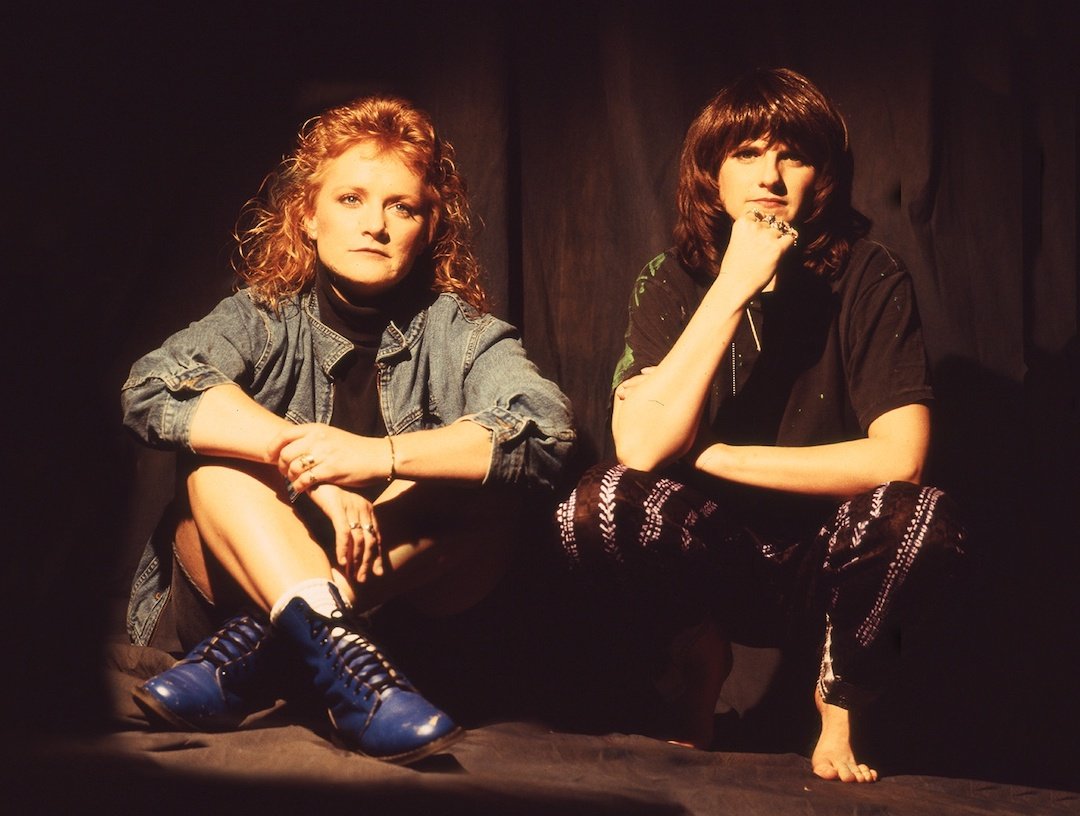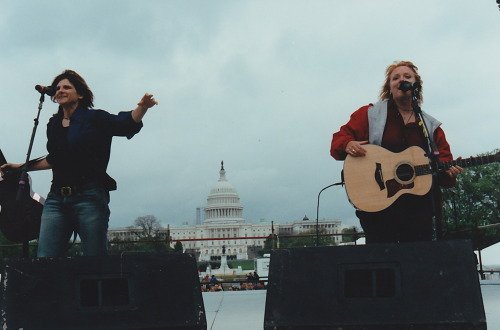Rabbit Rabbit #15: Life in Indigo
We all have backseat songs– songs that, when we were a kid riding in the car, seemed to always be playing on whatever radio station or CD for which our parents had a particular fondness. Their corresponding artists always took on a near-godlike quality. I have plenty of early-aughts backseat icons that evoke a familiar sense of comfort and reverence still today– Dave Matthews (“You and Me”), Shawn Colvin (“Sunny Came Home”), Suzanne Vega (“Luka”)…the list goes on. But none have grown more important to me over the years, and occupied such an integral space in my life and identity, than the Indigo Girls.
I went to the doctor / I went to the mountains / I look to the children / I drink from the fountains …the verse from the Girls’ 1989 hit “Closer to Fine” anyone this side of radio static is sure to know, and the verse that, try as I might, I can’t remember a life without. I have a memory from around 2010, sitting in the way back of a rental car while my dad drove us around on vacation in Charleston, South Carolina. “Least Complicated” was playing. My dad’s sister Jane and her partner Kathy had driven up to spend part of the trip with us and were also in the car. I remember my aunts pointing out the song, and mentioning they’d seen the Indigo Girls live many times together. The adults reached an agreement that the Girls were top-tier artists, a mindset I too adopted and have never let go.
Amy Ray and Emily Saliers met as elementary school students outside Decatur, Georgia. They began playing music together in high school and eventually while students at Emory University formed what is today known as the Indigo Girls, releasing their first full-length record album Strange Fire in 1987, followed by a self-titled album in 1989 that earned them a Grammy Award for Best Contemporary Folk Album. They have continued to release a steady stream of folk-rock music since, and have remained steadfast activists in communities both local (in Appalachia, the South, and various Native communities) as well as global.
1987
Before I knew any of this, I’d only ever heard the Girls on the radio. I had no idea as a kid what Amy and Emily looked like. Scratch that, I didn’t even know their individual names! So for a while, because they felt so intertwined, I just imagined them as Jane and Kathy in my head. My aunts sort of were the Indigo Girls to me. I’ve never met anyone cooler. I asked my parents to “turn it up” whenever I heard their music, which for too long was merely a rotation of their three or so greatest hits that might play on Sirius XM. I listened to “Galileo” all the time in high school, and wished I had more friends to rock out to these awesome tunes with.
As I’ve learned more about Amy and Emily’s friendship, creative partnership, and lifelong dedication to grassroots activism and community-building, I’ve come to realize that what I felt all along was a sense of belonging that many people have internalized before me. In a Rolling Stone interview, Brandi Carlisle cites the Indigo Girls as one of her strongest musical and personal influences. “They take their music to the people and play in places that don’t always have music,” she says of their touring tendencies. “In this way, they are true evangelists.” It’s true– throughout their careers, the Girls have played some epic venues, such as Red Rocks and Central Park, but they never stray from adding obscure towns, cities, and spaces to their schedules. “I know that music is undeniably central in our human search for meaning and belonging and getting in touch with mysteries,” Emily writes in the band’s blog. Everybody –everybody– deserves to experience it.
They take the same approach with their activism, starting small to create big change. In a talk entitled “The Persistence of Optimism,” Ray speaks a little about her and Saliers’ humble beginnings in North Georgia, playing clubs at 3 AM and working hard every week to secure their next gig. “When we were young and we were playing Little Five Points in Atlanta, what we saw around us was immediate need. We saw people who didn’t have anything to eat, our friends were getting AIDS, and our friends were addicted to drugs. And we said, okay, we can work on this to start with.” From there, the two made it their life’s mission to always “do a little more with their music,” whether that be raising money for a particular cause for justice at a gig, or inviting young emerging artists to play with them onstage. In 1993, they co-founded the non-profit organization Honor the Earth alongside esteemed Native activist Winona LaDuke, which is still around today and aims to solve community need-based issues for Native people.
Earth Day, D.C. 2000
Additionally, both Ray and Saliers, alongside a handful of other female musicians in the early ‘90s, were out as lesbians long before it was common for artists (or anyone in the public eye, for that matter) to be honest and open about their identities. Carlisle reminds us that, frequently the butt of jokes in the media and rejected by mainstream entertainment outlets, “[The Indigo Girls] have always maintained a sense of dignity, pride, and activism. They’ve overcome every time. They are exciting people that have no animosity or resentment towards the machine they worked on the fringe of all these years.”
When I was younger, the Indigo Girls represented an unspoken, gateway vortex into the simple possibility of gay existence. Listening to them felt safe and affirming in a way that I wasn’t able to articulate, but I knew that they meant something more to me because I was a certain way. It’s baked into their lyrics on a cellular level, often subtly, sometimes secretly, but Ray and Saliers have confidently and consistently imagined a world free of judgment, hate, prejudice, and shame through their songwriting and creative partnership. They uplift those who exist on the fringes, who dare to question the way things are, and who, above all, find joy in togetherness. (Not to mention how thrilling it is to hear their references to queerness become more overt as the years go by and you can trace the world beginning to open up alongside them.)
Even the opening line of “Closer to Fine” conjures a scene of delicate vulnerability and personal soul-searching: I’m tryin’ to tell you something ‘bout my life / Maybe give me insight between black and white. It makes me think of this line from Jodie Foster’s 2013 Golden Globes acceptance speech for the Cecil B. Demille Lifetime Achievement Award: “I already did my coming out about a thousand years ago in the Stone Age, in those very quaint days when a fragile young girl would open up to trusted friends and family, coworkers, and then gradually, proudly, to everyone who knew her, to anyone she actually met.” I suspect that my “quaint days” as a curious and creative adolescent will remain among the most challenging and beautiful of my life. I also know those years carried me through the confusion a little lighter because of the work women like my aunts (my first and favorite “Indigo Girls”), as well as Ray and Saliers and their predecessors, have done simply by living life as no one but themselves. I know that the journey was not easy.
In the past couple of years, I’ve expanded my repertoire to the Girls’ entire discography, including their two titillating live albums, 1995’s 1200 Curfews and 2010’s Staring Down the Brilliant Dream. It’s amazing to hear the real cheers of crowds of the past, singing the same songs that I’ve only recently learned. It’s a reminder of the power of gathering to see live performances.
When looking back on the past year, I realized this music has been the soundtrack to all that’s happened and changed, always inspiring me to do and be more as a person and artist. It’s also special to engage with music from the same artist over the years and be on the younger side of a fanbase. Of course, I would sell my soul to have been in the audience at Red Rocks in the summer of 1997. But attending two of their concerts for the first time in 2023, surveying the crowd, and noting the wide age range, I knew that I was carrying on a longstanding tradition of musical celebration and activism as a young listener. For that, I feel closer to fine than I have ever been.
***
Recs! A Song…
About self-preservation: “Fugitive”
To dance to: “Shame On You”
For appreciating beauty: “World Falls”
To get you up in the morning: “Hammer and a Nail”
For the readers: “Virginia Woolf”
With the best lyrics ever: “Fleet of Hope”




